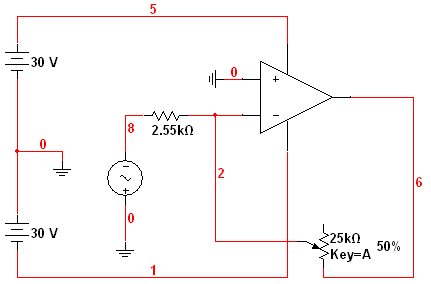Hi everyone,
I'm a Ph.D. student currently designing a general purpose voltage source to perform frequency response analysis on various elements. I'm using two OPA549 with their outputs in parallel to increase the total output current. The global schematic of my circuit is :
After some initial debugging, I came to test each of the Op-Amp independently. During one of these tests, I noted that the heat sinks of the Op-Amps became very hot even if their output were completely disconnected from the output stage. An example of such a test circuit was :
Here the only path to ground from the output is through the potentiometer, the 2.55k resistor and the signal source. The output current cannot be high enough to account for any significant heat of the chip, nor is the quiescent current wich is about 30 mA. The source signal used for this test was a 100kHz 10 Vpk sinusidal waveform, and after about 5 minutes of activity, the heat sinks of the Op-Amp (I use two 0.3°C/W heat sinks per Op-Amp, one at the tab and one at the front of the chip) became very hot when touched with hands. I don't think that this is a normal behaviour . A measurement of the output voltage gave the expected waveform however, consistent with theory.
Curiously , when I decrease the frequency of the signal source to 50 kHz (and below), no more excessive heat is generated and the heat sinks remain cool. This is puzzling. I would like to know what do you think is the cause of this problem, and if it has ever been encountered by anyone before. I doubt a solution can be found for it, and I'm now considering to limit the use of my circuit to 50 kHz maximum (instead of 100 kHz initially) seeing that much more heat would be generated at full load.
When I built my circuit, I soldered the wires directly on the pins of the Op-Amps using a professional 260/200 Watt soldering gun. This is a very effective tool but it generates so much heat that I think it could have damaged the chips somehow. Could it explain the problem? And if yes, seeing that my circuit works well at lower frequencies, should I still think of replacing my Op-Amps?
Thank's for your answers






